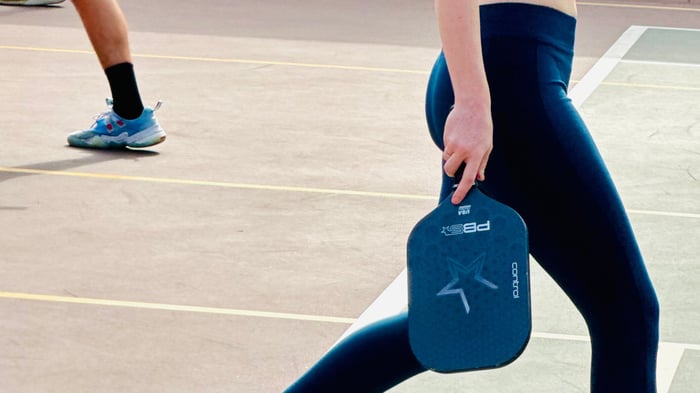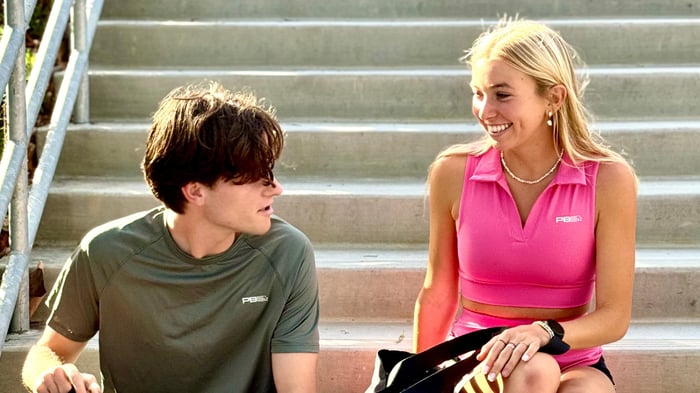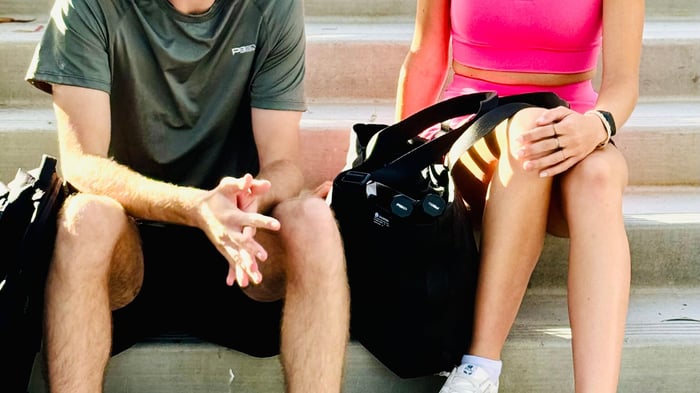Key takeaways:
Mastering pickleball footwork and grip techniques can dramatically improve your game and accuracy.
Minor adjustments in stance, pivoting, and maintaining a low center of gravity can enhance your overall performance.
Intentional practice using simple tools and targeted drills helps build lasting muscle memory.
Pickleball is fast, fun, and incredibly engaging, but it can also be frustrating when your form is off. Whether you're new to the game or have plenty of court time, poor technique can sneak in and hold you back without realizing it. Good form isn’t just about looking sharp; it’s the key to consistency, control, and playing your best every time you step on the court.
Even small form mistakes can significantly impact your performance, from awkward swings to slow footwork. The good news is that most of these issues can be fixed with awareness and the right practice approach. Clean, confident form helps you play more efficiently, prevent injuries, and enjoy the game even more. At PB5star, we’re all about assisting players to clean up their game, build better habits, and confidently enjoy every point.
Play smarter with a stronger form
Pickleball might look easy from the sidelines, but anyone who’s stepped on the court knows that finesse often beats force. That’s where good form comes in. Proper technique helps you control the ball, move efficiently, and avoid injuries that can sneak up from repeated bad habits. It’s the difference between barely returning a shot and confidently placing it where your opponent can’t reach.
Perfect pickleball form doesn’t just happen. Fatigue kicks in, old habits resurface, and pressure can throw even seasoned players off. Without feedback, it’s easy to miss that your paddle’s dropping too low or your footwork’s gone quiet. Muscle memory also plays a significant role; if you’ve repeatedly practiced something wrong, your body thinks it’s doing the right thing. The good news is, with some awareness and the proper corrections, you can retrain your form and take your game to the next level.
Common form mistakes and solutions
Even experienced players fall into bad habits on the court, especially when the pace picks up or fatigue sets. Whether you’re brand new to the game or just want to clean up your technique, recognizing these common slip-ups is the first step to playing smarter, faster, and more confidently. Let’s break down a few of the most frequent form mistakes and how to correct them.
Poor ready position
What it looks like: Standing too upright, paddle held too low or too close to the body.
Why it’s a problem: Slows your reaction time and limits your reach.
Fix it: Keep knees slightly bent and feet shoulder-width apart, and paddle up at chest level, ready for anything.
Ignoring your non-dominant hand
What it looks like: Non-dominant hand hanging by your side or doing nothing.
Why it’s a problem: Reduces balance, coordination, and paddle control.
Fix it: Engage your non-dominant hand to help guide your shots and keep your body aligned.
Over-swinging or muscling the ball
What it looks like: Big, tennis-style swings or trying to hit every shot hard.
Why it’s a problem: Leads to mishits, less control, and wasted energy.
Fix it: Focus on short, compact strokes and smart ball placement over brute force.
Flat-footed movement
What it looks like: Standing still or reacting late to shots.
Why it’s a problem: Hurts your ability to get into position quickly.
Fix it: Stay on the balls of your feet and use a small split step just before your opponent hits the ball.
Inconsistent grip or paddle angle
What it looks like: Switching grips mid-rally or holding the paddle too tightly/loosely.
Why it’s a problem: Causes unpredictable shots and poor control.
Fix it: Use a continental grip for versatility and keep your grip relaxed but secure.
Not watching the ball
What it looks like: Looking ahead before making contact or peeking too soon.
Why it’s a problem: Results in off-center hits and misjudged timing.
Fix it: Keep your eyes locked on the ball through contact every time.
Form mistakes happen to everyone, but they don’t have to stick around. With some awareness and simple adjustments, you can sharpen your technique and feel more in control on the court. Minor fixes can significantly improve consistency, confidence, and overall performance.
Fine-tune your form with purposeful practice
You don’t need a coach by your side to start improving your form. One of the most effective ways to self-correct is by recording yourself during drills or casual games. Seeing your movements on video can reveal things you might not notice in real time, like paddle position, stance, or footwork. Asking a partner for honest feedback or studying high-level players can also give you new insights and help you spot habits worth adjusting.
Muscle memory comes from quality practice, not just repetition. Rushing through drills with sloppy form won’t help much. Instead, focus on repeating each movement slowly and correctly. Isolating one skill at a time, like soft volleys, court positioning, or paddle control, helps reinforce proper technique. Even practicing alone against a wall can be powerful when you’re intentional about every shot. The more consistent your practice, the more naturally good habits will stick during real games.
Your pickleball practice toolkit
Improving your form isn’t just about knowing what to fix; it’s about having the right tools and practice routines to make those changes stick. You don’t need fancy equipment or a professional coach to make real progress. A few simple tools and targeted drills can help you build better habits, sharpen your skills, and reinforce good technique every time you step on the court.
Tools
Smartphone or tablet: Recording yourself while you play or practice is one of the easiest ways to catch form mistakes you might not notice in the moment. Just set it up courtside and review the footage afterward, you’ll be surprised how much you can learn from a few clips.
Cones or markers: Use cones, tape, or even water bottles to mark key spots on the court. They’re great for footwork drills, positioning practice, or setting targets during shot placement drills.
Grip trainer or overgrip tape: A grip trainer can help you build consistency and feel when holding the paddle, especially if you’re working on relaxing your grip or adjusting your paddle angle. Overgrip tape also gives you better control and can make your paddle feel more comfortable in your hand.
Drills
Split-step footwork: This drill is about staying light on your feet and ready for the next shot. Stand in your ready position and imagine you're in a rally. After every pretend swing or movement, do a small split-step. It helps train your body to reset quickly and stay balanced between shots.
Target practice: Place cones or visual markers in specific court zones and aim your shots toward them. This drill helps improve your accuracy and reinforces that clever placement often beats raw power in pickleball.
Controlled dinking drill: Grab a partner and stand at the kitchen line, gently dinking back and forth, focusing on soft hands and paddle control. It’s a great way to build muscle memory for touch shots and learn to keep the ball low and unattainable.
The more intentional you are with your practice, the more those minor improvements will add up over time. You’ll feel more confident in your movement, control, and overall game with just a few tools and consistent, focused drills. Keep it simple, stay consistent, and let the progress build.
Frequently asked questions (FAQ) about pickleball forms
If you're working on improving your form, you’re not alone; it's one of the most common areas players want to improve. Whether you're new to pickleball or just trying to clean up a few habits, having questions is normal. Here are some of the most frequently asked questions about form, technique, and how to keep improving your game confidently.
How can I tell if my pickleball form is hurting my game?
If you're missing easy shots, getting caught off guard at the net, or feeling like you're always a step behind, your form might be part of the problem. Paddle position, footwork, and grip can quietly interrupt your whole rhythm. A quick video of your play or some honest feedback from a partner can be super eye-opening.
Can I correct bad pickleball habits if I’ve played that way for a while?
For sure. Even long-time players can clean up their form with some focused practice. It might initially feel weird, but your body can relearn better habits. Start with one small change at a time, like your stance or grip, and build from there.
How much time should I spend working on my form during pickleball practice?
You don’t need to overhaul your whole session; a little dedicated time can go a long way. Even 10 minutes at the start of your practice, focusing on one part of your technique, can sharpen things up when you're back in game mode.
Do I need a pickleball coach to improve my form?
Not necessarily. A coach can help, but you can make significant progress independently. Use your phone to film drills, try targeted solo practice, or swap feedback with a hitting partner. What matters most is staying aware and intentional during practice.
The more you understand your form and how to improve it, the more confident and consistent you’ll feel on the court. Keep asking questions, stay curious, and don’t be afraid to make minor adjustments; those little changes can lead to significant improvements over time.
Unlock your full potential on the court
Improving your form isn’t about perfection; it’s about progress. Every minor adjustment you make can lead to more consistent shots, smarter movement, and a smoother overall game. With the right mindset and some focused practice, you’ll start to notice those improvements showing up in real-time play. Keep showing up, stay patient, and trust that every rep is moving you in the right direction.
The journey to better form is one of the most rewarding parts of becoming a stronger pickleball player. Players can level up their technique and play more confidently with the right tools, drills, and guidance. Staying intentional and consistent will help turn new habits into second nature. And as you refine your training, remember that the right gear matters too. PB5star’s performance apparel and gear are built to help you train harder, move better, and stay comfortable on the field, so you can focus on reaching your goals.







